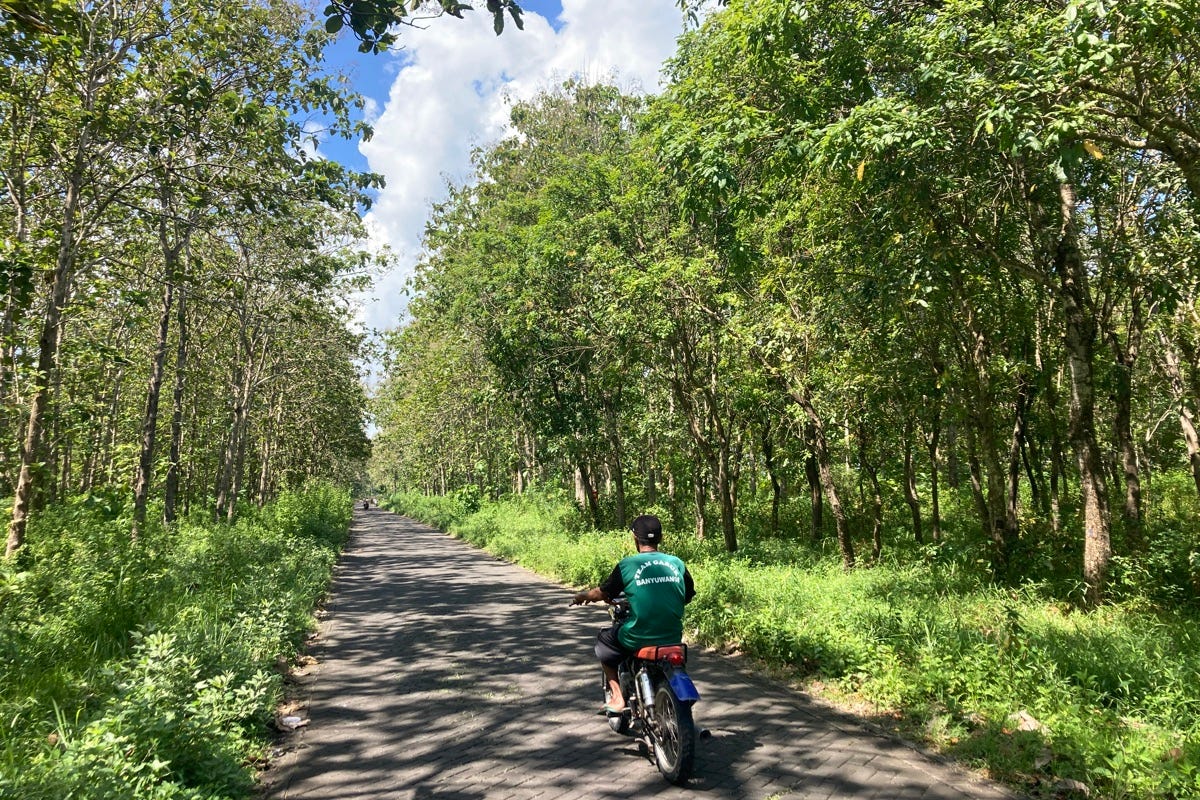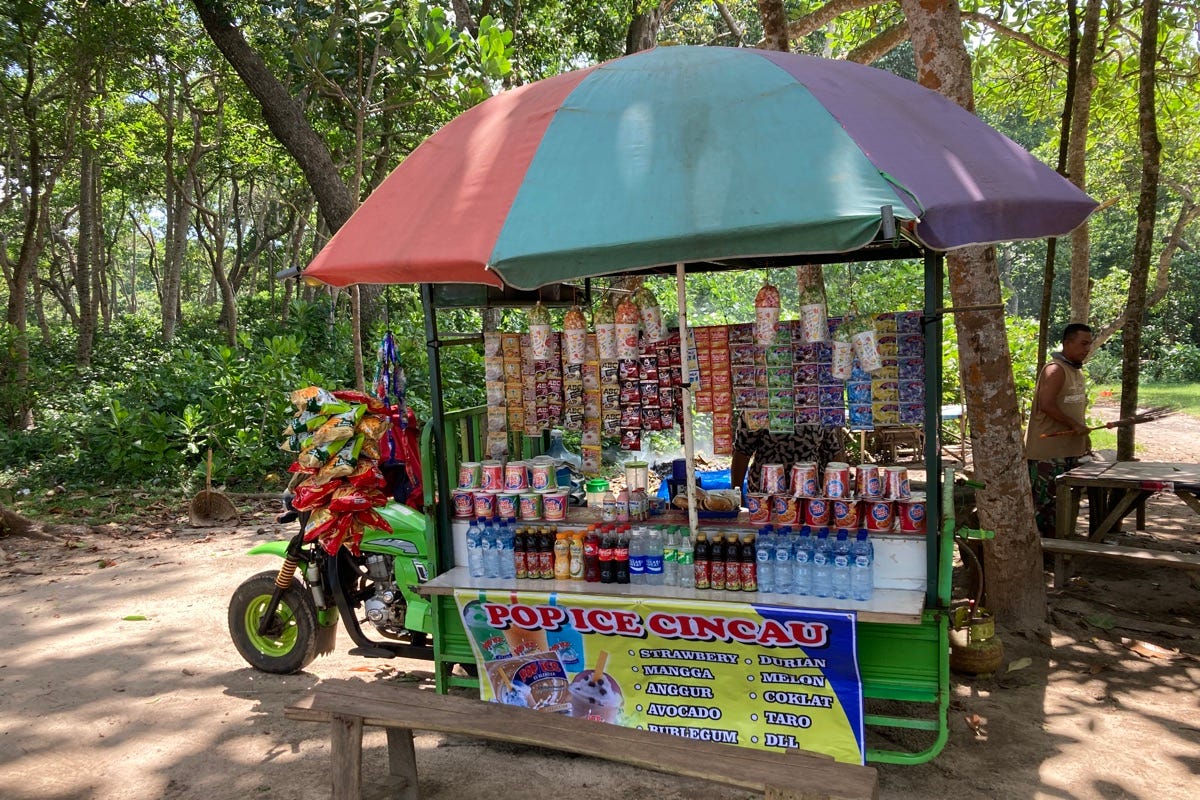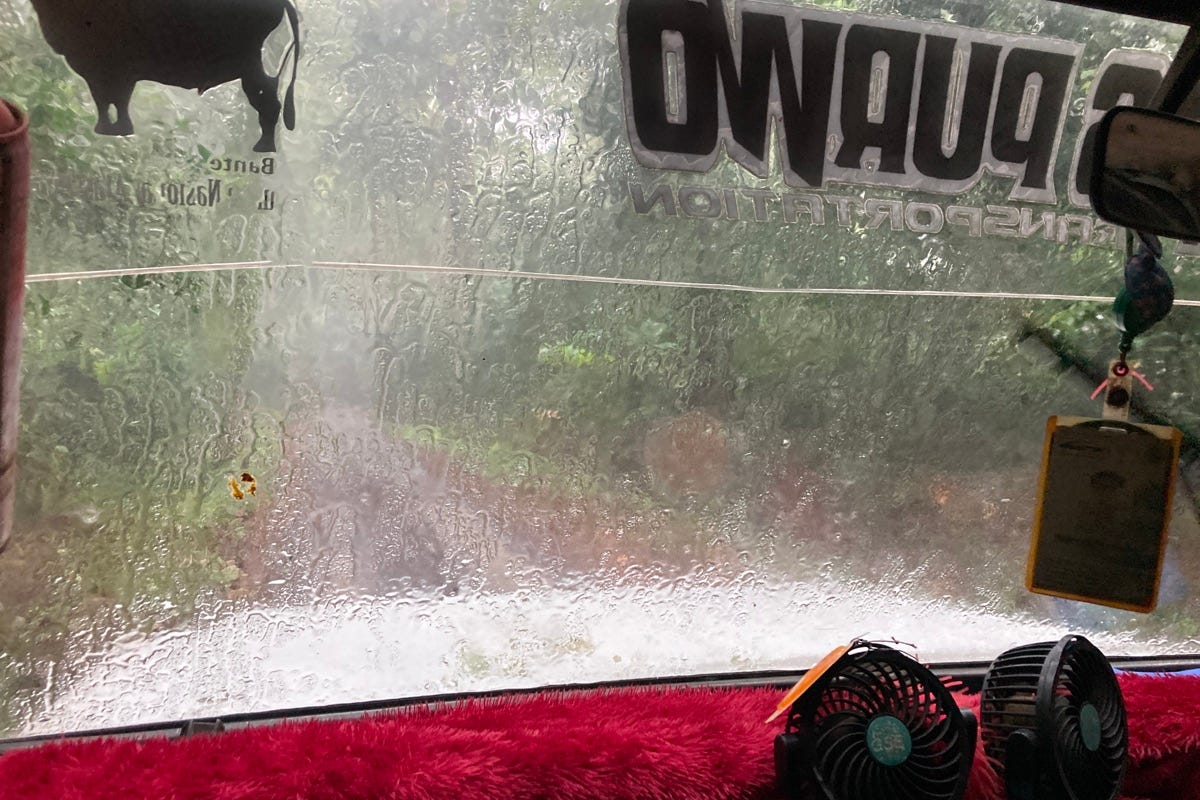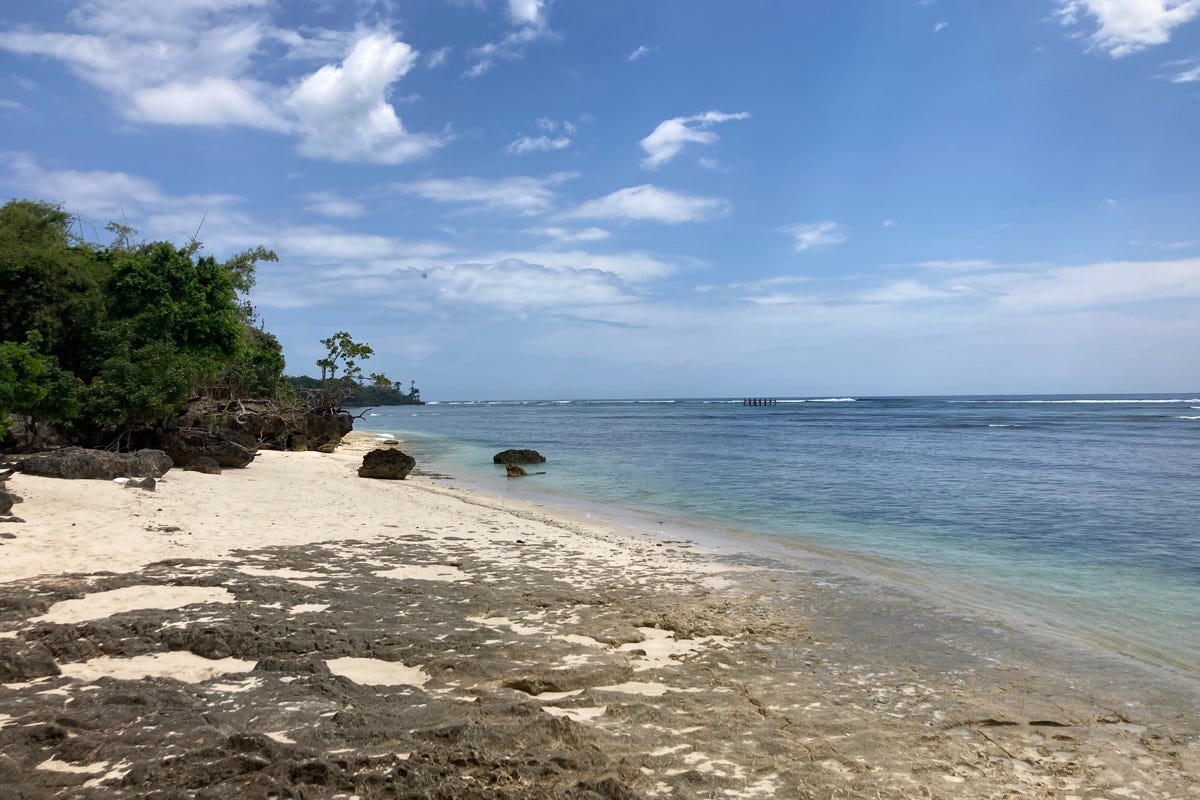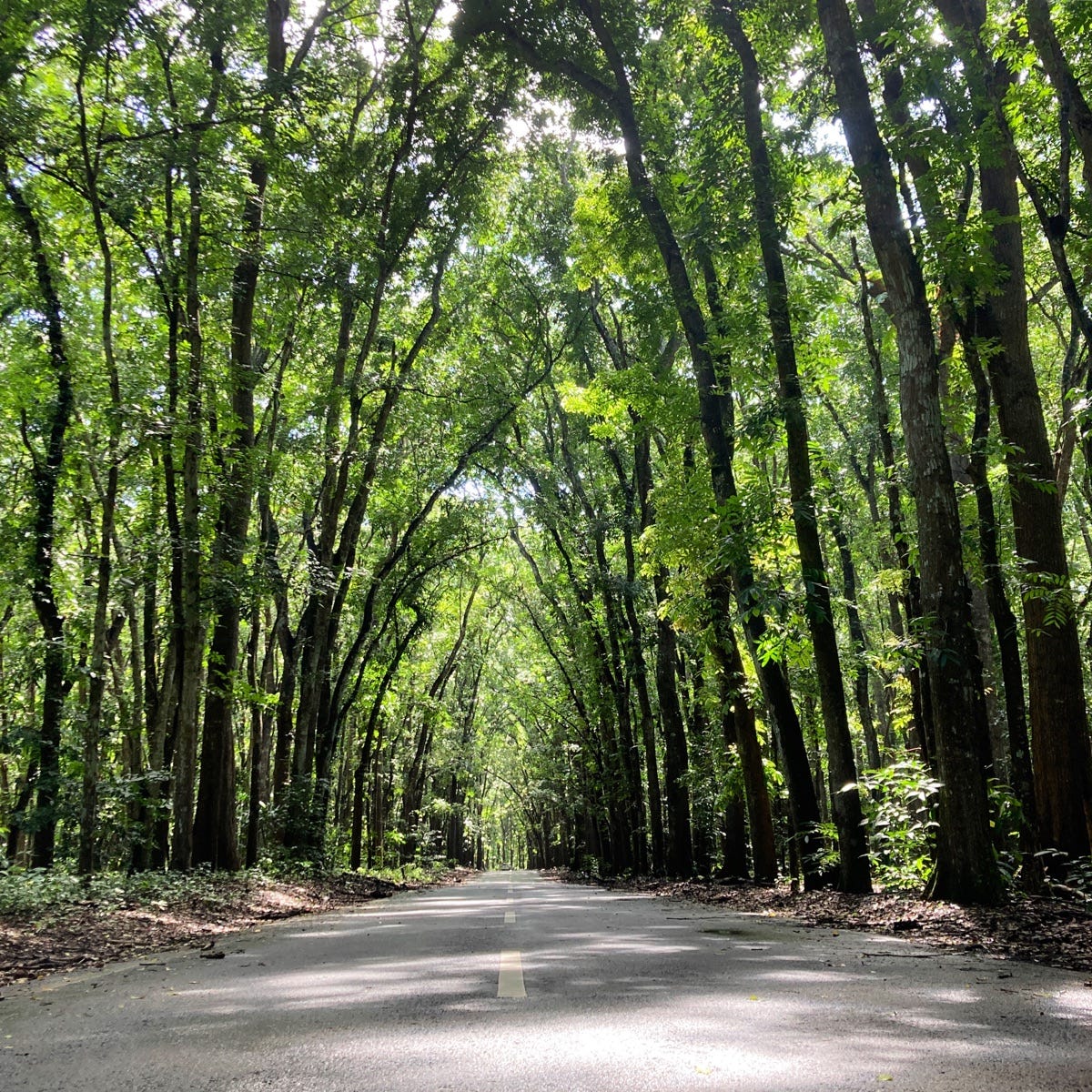The day starts with regrets. Regret that the hotel staffer was right. Regret I don’t have earplugs. Regret that the walls of our room are thinner than the lining of my eardrums. So many regrets, and it isn’t even 3 am yet.
I climb down, out of our bamboo extravagance and, guided by the light of my phone, I stumble through the grove to the paddy field’s edge. Along the embankment I go, till the grove falls back. I turn and took into the black. There are the distant lanterns of our guesthouse and above it, a million stars. The night is crystal clear, and to the right, looming distant behind our bamboo house is a black peak, as clear as a bell in the starlit sky. The Germans who checked in late last night are somewhere up there, trudging. Great weather for a climb.
Regrets are worth it sometimes.
The sun-dappled route towards the park, through what has replaced much of it. Photo: Stuart McDonald
About five hours later we’re back on the bike, retracing our route towards the coast, still just shy we turn right and head south. Our target, is the famed Alas Purwo National Park.
If you look at Java on Google Earth you’ll see its far east has a green sock that loops below Bali. This is the coast you can see from Bali on a clear day and also Alas Purwo National Park. A notionally protected area established in 1992, it covers almost 50,000 hectares—mid-sized by Java standards—and is believed to host Java’s oldest forests. Its name, Alas (forest) Purwo (early/ancient/beginning) reflects this. Or, to put it another way, Javanese mysticism holds that the earth first emerged from the ocean at Alas Purwo.
Seems legit. Photo: Stuart McDonald.
Old trees aren’t all the expanse holds though—riddled with caves, mysterious buried relics, and more than one jungle-surrounded Hindu temple, Alas Purwo is a hub of Java’s Ghost Empire.
I’ve written before about the dark arts in Bali, but within Indonesia, the practising of black magic is far from unique to Bali. While Lombok and to a lesser extent Nusa Penida are famed as places to refill your juju, the island of Java is bookended by hotspots, with Banten to the west and, you guessed it, Banyuwangi to the east, famous for their dark art practitioners.
Make an offering to keep the ghosts at bay. Photo: Stuart McDonald.
Known as dukun, they can turn their talents to all manner of subjects, both to cause mayhem or to undo the handiwork of other dukuns. Not something one majors in at college, rather a gift (or curse) bestowed, often through a dream or vision, sometimes passed down by a parent. As I wrote of the Balian I met on Bali:
“His power (again, like magic, a poor word to use) came to him years ago—“a gift from the spirits,” he says. It came to him before he was married and, through the years, his power has strengthened. He knows the way of the light and the dark, he says, and he can help those in need—regardless of if their needs are good or evil.”
In Banyuwangi’s case, many dukun head to Alas Purwo, to wander its labyrinth of forest trails and meditate in its caves, to touch the earth and harness its powers. Not only the power of the forest but of the spirits and ghosts that inhabitant it.
Next stop Exmouth. Photo: Stuart McDonald.
There’s Princess Gayatri Sri Rajapatni, a relic of the Majapahit Kingdom—if you’re camping and sleeping fitfully, don’t be surprised to encounter her, dressed in a traditional kemben with a beautiful shawl over her shoulder. She’ll chat with you about how she’s lived in the park for ages, since before Indonesia existed, her duty to promote peace and well being. Ghostly chit chat over, she fades into the forest, and you’ll fall into a peaceful sleep surrounded by a “princess fragrance.”
Others have reported on meeting meditating mystics who’ve encountered both Mohammad Hatta and Sukarno while meditating. Buttressing the park’s reputation as a layover for long-gone kings.
The forests sheltering these ethereal beings once stretched along Java’s south coast to at least below Jember, over time much was cleared for farming or simply by illegal logging, driving a wedge to the sea, separating Alas Purwo from Meru Betiri National Park to the west. In 1998’s heady post-Suharto days, as President Habibie struggled to hold things together, illegal logging ratcheted up while around the same time, plans surfaced to “develop” the park for tourism. Road construction in the park was repeatedly beset by “paranormal challenges.” The seat of the Ghost Empire was unsettled.
Coffee, please. Photo: Stuart McDonald.
Simultaneously, from mid to late 1998, a raft of killings was unleashed in Banyuwangi with almost 150 alleged dukuns killed, often by beheading. The climate of fear and chaos is driven by unknown sources as varied as you can imagine—from politicking to coups, to religious posturing, to, you guessed it, tapping down the dukuns to clear a way for development in the park. Yes it might sound unusual, but then take this quote from a New York Times report at the time:
“It begins when people try to chase someone suspicious,” explained Sukiando, a 42-year-old rickshaw driver who said he was in the mob that beheaded one suspect on Sunday. “Sometimes the ninja turns into a cat, and sometimes he stays human. If he stays human, then they cut off his head.”
Sounds like a rough deal to me. Regardless, the illegal logging was pulled somewhat into line, and the development of the park into grander tourism schemes ground to a halt. The Ghost Empire sunk back into the woods.
Lovely. Photo: Stuart McDonald.
It’s a solid two-hour ride from our bamboo house to the park. After paying our 30 times local admission to enter, we ride past the “park information centre”, its smashed windows and empty halls ridiculing us for paying a premium that clearly goes nowhere near park management, and into the woods. The sounds of civilization vanish—other than our motorbike of course.
We reach the primary Hindu temple, Pura Kawitan Alas Kurwo, where a clutch of faithful go about their rituals, their glowing white garb bright against the forest’s deep greens and the charcoal grey of the temple. A bell tinkles somewhere, a driver, bored, leans against his van, waiting, smoking, staring at us. We push on.
At Pantai Trianggulasi, the beach is broad, grey to white sanded, clear warm waters wash in. The high tide point is marked by a colossal amount of trash, both flotsam and plastic, as with the beach, it stretches for miles. Big signs warm not to swim due to dangerous rips—get swept away here and it is next stop Exmouth. We just paddle.
Glad to not be on the bike. Photo: Stuart McDonald.
Onwards at Pantai Pancur a small waterfall drops into the sand, emptying out to sea. At its base, the rubbish, rich in styrofoam is six inches thick. I think there’s a metaphor here but am too depressed to think of what it is. By the empty campground a difficult-to-see trail leads off to caves a few kilometres away—we pass.
From here we can ride no further, a jeep is required to reach Pantai Plengkung, so we cough up the 250,000 rupiah for the twenty-minute drive. As we leave, a storm blows in, raindrops the size of rambutan pelt down, putting the R in rainforest. We surprise a family of wild pigs that scurry across the road in front of us, diving into the forest so thick they vanish in seconds. We cross small inlets, the mangrove roots choking in decorative styrofoam, flip flops, bras and plastic bottles. What else should you expect along the coastline of the second-largest contributor to ocean debris on the planet?
Our driver harks from Bandung, but he’s worked here for over twenty years, as he drives he talks of seeing tigers in the forest. When he finds out we’re Australian he rattles off the Australian towns he knows surfers from—Melbourne, Perth, Sydney and Bondi. I’m dubious about the tiger story but don’t tell him Bondi is a part of Sydney. He’s so far from Bandung on account of his Banyuwagian wife, though she’s in Taiwan on a three-year work placement—he hopes to see her in a year. Globalization flows within our Jeep as the rain pours through my broken window.
The surf was not up. Photo: Stuart McDonald.
Like most tropical storms, by the time we reach Plengkung it has eased, we wander by the boat landing for the speedboats that hustle over surfers from Bali to ride some of the best breaks in the country, then the helipad for the flash surfers, beyond it a huge deer, antlers reaching for the sky stares at us unblinking, eerily like the guy in the temple car park.
The sea is pretty, that beautiful blue topped by the moving foam the tropics do so well. The surf is flat, but regardless it’s a sight.
There are a few Australians dossing about and I ask after getting a meal from the nearby surf camp. They explain the stay is full board with set meals, so they doubt we’d get fed. I refuse with a smile the offer of a muesli bar one has in his back pocket and we hike back to the jeep.
Not a ghost in sight. Photo: Stuart McDonald.
On our way out we pass by the “savannah.” Cut out of the jungle in the 1980s to form a paddock for feeding endangered animals, it seems out of place in a national park, domestic tourists surreptitiously photograph Will and me as much as the beasts in front of us.
Then we’re out, racing down the tarmac with the vaulted church roof trees above, past the vast teak plantations, then dragon fruit, then villages. It’s two hours to Pantai Pulau Merah and it’s so lovely that within an hour of arriving we decide to stay an extra night.
These trip plans you see, are made for breaking.
Couchfish is 100 per cent independent and reader-supported. If you’re not already a subscriber, and you’d like to show your support, become a paying subscriber today for just US$7 per month—you can find out more about Couchfish here—or simply share this story with a friend.
Don’t forget, you can find the free podcasts on Apple, Pocket Casts and Spotify as well as right here on Couchfish.


